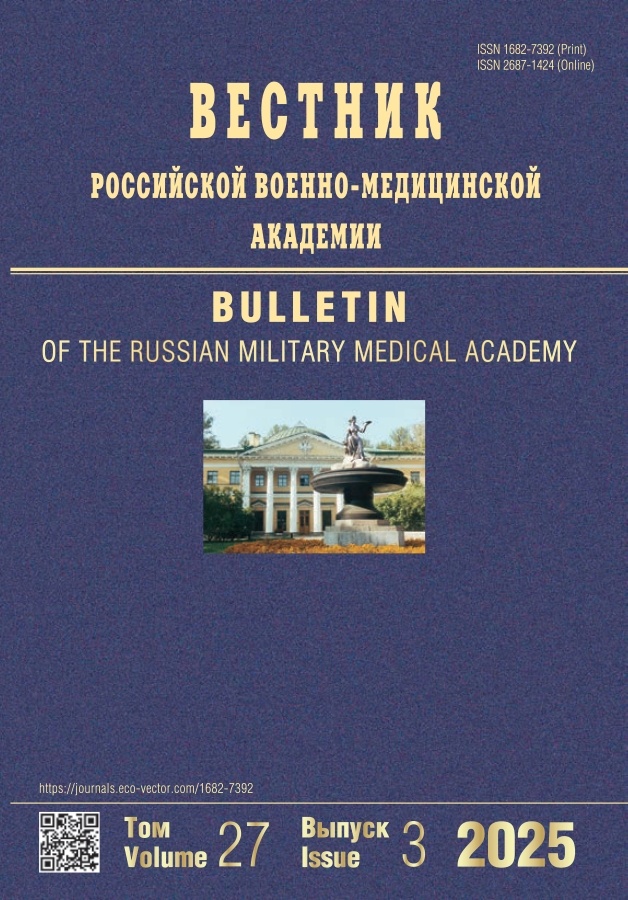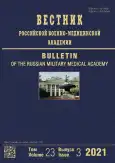Prevention of complications of transpapillary endoscopic interventions
- 作者: Feklyunin A.A.1, Romashchenko P.N.1, Maistrenko N.A.1, Omran V.S.2
-
隶属关系:
- Military Medical Academy named after S.M. Kirov of the Ministry of Defense of the Russian Federation
- 6 Military Hospital of the Russian National Guard Troops
- 期: 卷 23, 编号 3 (2021)
- 页面: 141-147
- 栏目: Clinical trials
- URL: https://journals.rcsi.science/1682-7392/article/view/75709
- DOI: https://doi.org/10.17816/brmma75709
- ID: 75709
如何引用文章
详细
This study analyzed the treatment results of 345 patients who underwent planned and emergency transpapillary surgical interventions for various diseases of the biliopancreatoduodenal region. Among these patients, 68.9% were women and 31.1% were men aged 18–92 (mean age, 63.7 ± 4.5) years. The study included patients who used various types of transpapillary endoscopic interventions as a treatment method, such as endoscopic papillo-sphincterotomy (71.9%, including choledocholite extraction in 68.7% of the patients), endoprosthetics of the common bile duct and main pancreatic duct (17.8%), balloon dilatation and bougienage of bile duct strictures (6.2%), mechanical lithotripsy (2%), nasobiliary drainage (1%), endoscopic wirsungotomy (0.8%), and endoscopic papillectomy (0.3%). Variants of the inflow of hepaticoholedochus and Wirsung duct were assessed using magnetic resonance cholangiopancreatography. The active implementation of preventive measures regulated by the global community made it possible to reduce the overall incidence of complications of transpapillary interventions to 13.1% and the rates of postoperative mortality to 1.3% (p < 0.05). The use of these measures led to a significant decrease in the incidence of acute post-manipulation pancreatitis from 10.3% to 4.8%, postoperative bleeding from 8.9% to 5.5%, cholangitis from 2.8% to 0.7%, and a low incidence of retroduodenal perforation in 1.1%. Personalized consideration of the modern recommendations of the global endoscopic communities (Europeans, Americans, and Japanese) when performing endoscopic retrograde cholangiopancreatography, as well as original approaches associated with the determination of the anatomical features of the structure of the Vater papilla with variants of fusion of hepaticocholedochus and Wirsung duct, helped to significantly reduce the overall incidence of complications following transpapillary endoscopic procedures from 22.2% to 13.1%.
作者简介
Aleksey Feklyunin
Military Medical Academy named after S.M. Kirov of the Ministry of Defense of the Russian Federation
编辑信件的主要联系方式.
Email: a.feklyunin@mail.ru
ORCID iD: 0000-0003-0024-4825
SPIN 代码: 8925-0955
candidate of medical sciences
俄罗斯联邦, Saint PetersburgPavel Romashchenko
Military Medical Academy named after S.M. Kirov of the Ministry of Defense of the Russian Federation
Email: romashchenko@rambler.ru
ORCID iD: 0000-0001-8918-1730
SPIN 代码: 3850-1792
doctor of medical sciences, professor
俄罗斯联邦, Saint PetersburgNikolai Maistrenko
Military Medical Academy named after S.M. Kirov of the Ministry of Defense of the Russian Federation
Email: nik.m.47@mail.ru
ORCID iD: 0000-0002-1405-7660
SPIN 代码: 2571-9603
doctor of medical sciences, professor
俄罗斯联邦, Saint PetersburgValentin Omran
6 Military Hospital of the Russian National Guard Troops
Email: omrans@mail.ru
ORCID iD: 0000-0003-4092-3224
SPIN 代码: 5089-1695
senior resident
俄罗斯联邦, Novosibirsk参考
- Cotton PB, Garrow DA, Gallagher J, et al. Risk factors for complications after ERCP: a multivariate analysis of 11,497 procedures over 12 years. Gastrointest Endosc. 2009;70(1):80–88. doi: 10.1016/j.gie.2008.10.039
- Rustagi T, Jamidar PA. Endoscopic retrograde cholangio-pancreatography-related adverse events: general overview. Gastrointest Endosc Clin N Am. 2015;25:97–106. doi: 10.1016/j.giec.2014.09.005
- Glomsaker T, Hoff G, Kvaloy JT, et al. Patterns and predictive factors of complications after endoscopic retrograde cholangiopancreatography. Br J Surg. 2013;100(3):373–380. doi: 10.1002/bjs.8992
- Ryozawa S, Itoi T, Katanuma A. Japan Gastroenterological Endoscopy Society guidelines for endoscopic sphincterotomy. Digestive Endoscopy. 2018;30(2):149–173. doi: 10.1111/den.13001
- Chandrasekhara V, Khashab M, Muthusamy V, et al. Adverse events associated with ERCP. Gastrointest Endoscopy. 2017;85(1): 32–47. doi: 10.1016/j.gie.2016.06.051
- Dumonceau J-M, Kapral C, Aabakken L, et al. ERCP-related adverse events: European Society of Gastrointestinal Endoscopy (ESGE) Guideline Endoscopy. 2020;52(2):127–149. doi: 10.1055/a-1075-4080
- Freeman ML. Complications of endoscopic retrograde cholangiopancreatography: Avoidance and management. Gastrointest Endosc Clin N Am. 2012;22(3):567–586. doi: 10.1016/j.giec.2012.05.001
- Fedorov AG, Davydov SV, Klimov AE. Complications of Endoscopic Transpapillary Interventions, Approaches to Prevention And Treatment. Russian Sklifosovsky Journal of Emergency Medical Care. 2012;3:29–35. (In Russ.)
- Dumonceaul J-M, Andriulli A, Elmunzer BJ, et al. Prophylaxis of post-ERCP pancreatitis: European Society of Gastrointestinal Endoscopy (ESGE) Guideline — updated June 2014. Endoscopy. 2014;46(9):799–815. doi: 10.1055/s-0034-1377875
- Romashchenko PN, Feklyunin AA, Maistrenko NA, et al. Transpapillyarnye endoskopicheskie operacii: prediktory oslozhnenij i profilaktika ih razvitiya. Endoscopic Surgery. 2021;27(1):40–48. (In Russ.). doi: 10.17116/endoskop20212701140
- Pryadko AS, Maistrenko NA, Romashchenko PN, et al. Endoskopicheskie i punktsionnye metodiki v diagnostike i lechenii khronicheskogo pankreatita. Vestnik neotlozhnoi i vosstanovitel’noi meditsiny. 2013;14(4):493–498. (In Russ.). doi: 10.24884/0042-4625-2015-174-5-22-31
- Romashchenko PN, Maistrenko NA, Kuznecov AI, et al. Malignant Obstructive Jaundice: Justification of The Method of Biliary Decompression. Annals of Hpb Surgery. 2020;25(2):124–136. (In Russ.). doi: 10.16931/1995-5464.20202124-136
- Vasil’ev AYU, Ratnikov VA. Magnitno-rezonansnaya holangiografiya v diagnostike zabolevanij zhelchevyvodyashchih putej: monografiya. Moscow: Medicina; 2006. 200 p. (In Russ.).
- Rebrova OYu. Statisticheskij analiz medicinskih dannyh. Primenenie paketa prikladnyh programm Statistica. Moscow: MediaSfera; 2002. 312 p. (In Russ.).
- Mariani A, Giussani A, Di Leo M, et al. Guidewire biliary cannulation does not reduce post-ERCP pancreatitis compared with the contrast injection technique in low-risk and high-risk patients. Gastrointest Endosc. 2012;75(2):339–346. doi: 10.1016/j.gie.2011.09.002
- Tse F, Yuan Y, Moayyedi P, et al. Guide wire-assisted cannulation for the prevention of post-ERCP pancreatitis: a systematic review and meta-analysis. Endoscopy. 2013;45(8):605–618. doi: 10.1055/s-0032-1326640
- Elmunzer BJ, Scheiman JM, Lehman GA, et al. A randomized trial of rectal indomethacin to prevent post-ERCP pancreatitis. N Engl J Med. 2012;366(15):1414–1422. doi: 10.1056/nejmc1205928
- Ding X, Chen M, Huang S, et al. Nonsteroidal anti-inflammatory drugs for prevention of post-ERCP pancreatitis: a meta-analysis. Gastrointest Endosc. 2012;76:1152–1159. doi: 10.1016/j.gie.2012.08.021
- Puig I, Calvet X, Baylina M, et al. How and when should NSAIDs be used for preventing post-ERCP pancreatitis? A systematic review and meta-analysis. PLoS One. 2014;9(3):e92922. doi: 10.1371/journal.pone.0092922
- Mazaki T, Mado K, Masuda H, et al. Prophylactic pancreatic stent placement and post-ERCP pancreatitis: an updated meta-analysis. J Gastroenterol. 2014;49(2):343–355. doi: 10.1007/s00535-013-0806-1
- Buxbaum J, Yan A, Yeh K, et al. Aggressive hydration with lactated Ringer’s solution reduces pancreatitis after endoscopic retrograde cholangiopancreatography. Clin Gastroenterol Hepatol. 2014;12(2):303–307. doi: 10.1016/j.cgh.2013.07.026
- Wu BU, Hwang JQ, Gardner TH, et al. Lactated Ringer’s solution reduces systemic inflammation compared with saline in patients with acute pancreatitis. Clin Gastroenterol Hepatol. 2011;9(8): 710–717. doi: 10.1016/j.cgh.2011.04.026
- Park DH, Kim MH, Lee SK, et al. Endoscopic sphincterotomy vs. endoscopic papillary balloon dilation for choledocholithiasis in patients with liver cirrhosis and coagulopathy. Gastrointest Endosc. 2004;60(2):180–185. doi: 10.1016/s0016-5107(04)01554-8
- Tsujino T, Isayama H, Komatsu Y, et al. Risk factors for pancreatitis in patients with common bile duct stones managed by endoscopic papillary balloon dilation. Am J Gastroenterol. 2005;100(1):38–42. doi: 10.1111/j.1572-0241.2005.40638.x
- Cotton PB, Connor P, Rawls E, et al. Infection after ERCP and antibiotic prophylaxis: a sequential quality-improvement approach over 11 years. Gastrointest Endosc. 2008;67(3):471–475. doi: 10.1016/j.gie.2007.06.065
- Bangarulingam SY, Gossard AA, Petersen BT, et al. Complications of endoscopic retrograde cholangiopancreatography in primary sclerosing cholangitis. Am J Gastroenterol. 2009;104(4):855–860. doi: 10.1038/ajg.2008.161
- Sawas T, Al Halabi S, Parsi MA, et al. Self-expandable metal stents versus plastic stents for malignant biliary obstruction: a meta-analysis. Gastrointest Endosc. 2015;82(2):256–267. doi: 10.1016/j.gie.2015.03.1980
- Costamagna G, Boskoski I. Current treatment of benign biliary strictures. Ann Gastroenterol. 2013;26(1):37–40. doi: 10.1016/b978-0-323-48109-0.00043-2
补充文件








